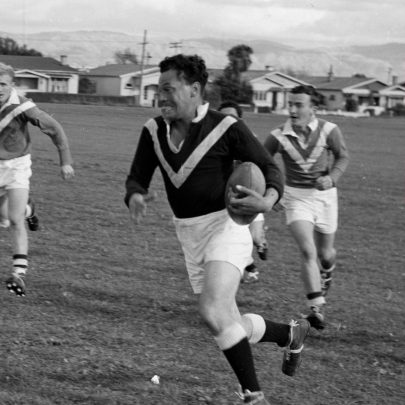Aug 9, 2023 Sport
It’s a sorry sight out at North Harbour Stadium. The great arching stand that faces westward is empty and fading in the cold shade that it provides. Across the other side of the lush field, there’s a visual metaphor for just how off course the park’s life has gone — a giant, gaping hole where you can see through to the synthetic practice pitches beyond. One of the stadium’s key tenants, the Auckland Tuatara baseball club, has folded, leaving almost $2 million in debt and taking with it the plan for filling the gap where the eastern stand used to be.
As a community sport complex, there’s certainly nothing wrong with North Harbour Stadium’s contribution to rugby, football and other sports, but the deeply depressing thing is what it could have been. Home to more than its handful of All Black tests, sure. Maybe even a revamped outer oval that could have been a proper international cricket ground for Auckland. But its most important legacy should have been the impetus to kickstart a major revamp of public transport infrastructure for the North Shore.
Things were different back in 1997 when NHS opened. Rugby had only just started being played under lights, players still wore thick cotton jerseys with their collars up and the area around the stadium had barely begun its development. But NHS was only ever half built: one stand completed and the other ready to go up as soon as the ageing Eden Park was finally given its last rites. Back then, Eden Park was a collection of four different stands built in as many decades. It was imposing when full, but shambolic otherwise. In NHS’s first year of existence, it hosted the All Blacks against Fiji and the momentum was set for it one day to be the premier sports ground in Auckland, and therefore the country.
A fully developed NHS could have held 60,000 fans. The large field on the outside of the main stand is the perfect shape and size for a test cricket ground, with room for a decent stand and traditional embankment for summer crowds. The land surrounding it was fully RMA-ed, so work could have started straight away.
Plus, upgrading such a large complex would have meant more people needing to get there and back. The bus lane that runs along the Northern Motorway would have been a train line, and that would have needed a rail crossing, which would have meant either an upgrade to the Harbour Bridge or a new alternative. Whatever the outcome, it would have been better than the reality of getting to and from that part of town now.
Meanwhile, back across the bridge and down the Southern Motorway, business is seemingly booming. Mt Smart is now Go Media Stadium and, at least in 2023 anyway, is the go-to venue for almost every sport that’s played outside with a large ball. On one four-day stretch alone in March, Mt Smart hosted Super Rugby, NRL and an international football friendly between the All Whites and China. But while the Warriors have been pulling in big crowds for their games, the story is different for the stadium’s other tenant. Moana Pasifika’s woes on the field — only three wins in two seasons — have been matched by those off it, with crowds looking threadbare throughout their run of home games this season. When empty, Mt Smart’s stands are a cold and forbidding place, the wind whistling through the now 33-year-old eastern stand and the outdated halogen lighting contributing to a slightly murky atmosphere. It’s not so much of an issue when the Warriors have 20,000 in, cheering them on, but it made the mere dozens who watched Moana lose to the Melbourne Rebels feel like even less. But Mt Smart has managed, through good luck and New Zealand Rugby’s commitment to Auckland, to host both the All Blacks and Black Ferns this season. It’s the second time for the men and the first for the women, with NZ Rugby getting some sort of deal for both.
The reason they’re there at all is because of the situation at the most talked-about venue in Auckland. The new LED lights at Eden Park beam so bright that you almost have to avert your gaze all the way over in Grey Lynn. The lights have been put in as the 123-year-old park gears up to host the FIFA Women’s World Cup, with the most powerful sporting body’s rules stating that everything to do with the playing conditions be as perfectly uniform as possible. FIFA are essentially owners of Eden Park for the duration of the tournament.
Despite what promises to be a spectacular event — easily the showpiece sporting event of the year — it won’t do much to dissuade Eden Park’s detractors. What started as a large, empty patch of ground on the city’s boundaries is now surrounded by some of the most sought-after real estate in Auckland, occupied by some people who wouldn’t mind it one bit if it got packed up and moved somewhere else.
But where? The waterfront?
That’s less likely than ever. The announcement that Eden Park would host nine Women’s World Cup games killed off any speculation, which is unlikely to return, with no major international sports events on the horizon for New Zealand, unless a bid is put in for the Commonwealth Games. Such a bid would be a seriously divisive issue, given the questions over its contemporary relevance, and debate would naturally extend to the building of what could be a project in excess of $1.5 billion.
Eden Park has stubbornly hung in there, it has to be said. It has withstood two major periods where its neck was on the block: when NHS was completed and when options were mooted for the venue to host the 2011 Rugby World Cup. Despite its grandiose, self-appointed title of ‘New Zealand’s National Stadium’, the success the All Blacks have had in the now almost 30-year win streak at the stadium counts for quite a lot in the court of public opinion.
But that doesn’t disguise Eden Park’s problems. Its key tenant, the Blues, are heavily reliant on their strength of schedule to get fans through the gate, while the Auckland NPC side couldn’t fill one of the stands if they gave away all the tickets for free. And earlier this year, Eden Park’s upgrade plans were leaked, including a roof, contractible stands, a new concourse and other amenities, but no cost, no build time, no details. You didn’t need to be an architect or construction boss to figure out the answer figure to all three of those would be high.
If only there was something already set up to replace it … which brings us back to Albany, back to the unloved and defaced North Harbour Stadium. That’s where things could have been developed and shaped into a complex befitting major events. A place you could catch a train to and from, as with any proper stadium, surrounded by a precinct of supplementary services and amenities. That could have been started 20 years ago. Oh well.
–
This story was published in Metro N°439.
Available here.






